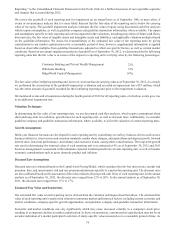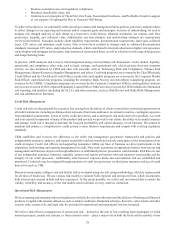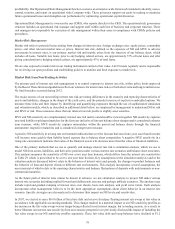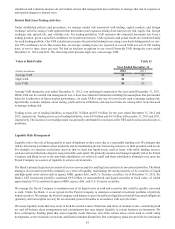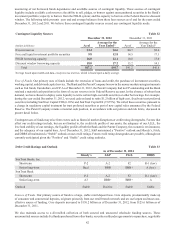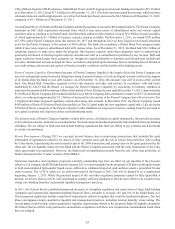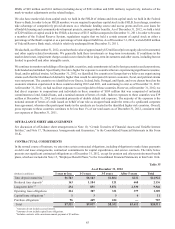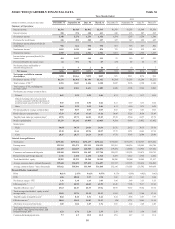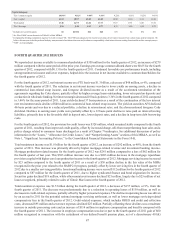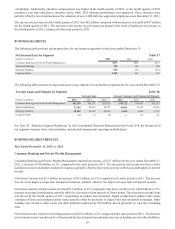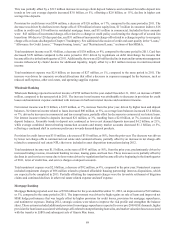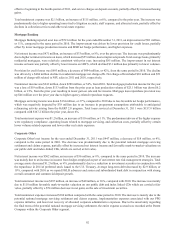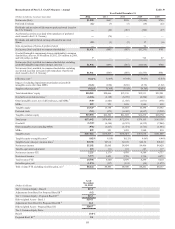SunTrust 2012 Annual Report Download - page 99
Download and view the complete annual report
Please find page 99 of the 2012 SunTrust annual report below. You can navigate through the pages in the report by either clicking on the pages listed below, or by using the keyword search tool below to find specific information within the annual report.83
CDs, offshore deposits, FHLB advances, Global Bank Notes, and CP. Aggregate wholesale funding decreased to $15.3 billion
as of December 31, 2012, from $17.5 billion as of December 31, 2011. Net short-term unsecured borrowings, which includes
wholesale domestic and foreign deposits, as well as Fed funds purchased, decreased to $4.5 billion as of December 31, 2012,
compared to $5.1 billion as of December 31, 2011.
As mentioned above, the Bank and Parent Company maintain programs to access the debt capital markets. The Parent Company
maintains an SEC shelf registration statement from which it may issue senior or subordinated notes and various capital
securities such as common or preferred stock. Our Board has authorized the issuance of up to $5.0 billion of such securities,
of which approximately $1.7 billion of issuance capacity remains available. On November 1, 2011, we issued $750 million
of 3.50% senior Parent Company notes due January 20, 2017 and throughout 2012 we have issued several small structured
notes for the Parent Company in the amount of $80 million. The Bank also maintains a Global Bank Note program under
which it may issue senior or subordinated debt with various terms. As of December 31, 2012, the Bank had $36.1 billion of
remaining capacity to issue notes under the program. Our issuance capacity under these programs refers to authorization
granted by our Board, or formal program capacity, and does not refer to a commitment to purchase by any investor. Debt and
equity securities issued under these programs are designed to appeal primarily to domestic and international institutional
investors. Institutional investor demand for these securities is dependent upon numerous factors, including but not limited to
our credit ratings and investor perception of financial market conditions and the health of the banking sector.
Parent Company Liquidity. Our primary measure of Parent Company liquidity is the length of time the Parent Company can
meet its existing and certain forecasted obligations using its present balance of cash and liquid securities without the support
of dividends from the Bank or new debt issuance. As of December 31, 2012, this measure was well in excess of the current
limit. Our Board Risk Committee regularly reviews this measure and other risk metrics. In accordance with risk limits
established by ALCO and the Board, we manage the Parent Company’s liquidity by structuring its maturity schedule to
minimize the amount of debt maturing within a short period of time. During the year ended December 31, 2012, approximately
$1.0 billion of Parent Company debt matured and there is no Parent Company debt scheduled to mature in 2013. As mentioned
above, we redeemed approximately $1.2 billion of trust preferred securities at the Parent Company that will not receive Tier
1 Capital credit under proposed regulatory capital rules using cash on hand. In December 2012, the Parent Company issued
$450 million of Series E Preferred Stock that qualifies as Tier 1 Capital under the new regulatory capital rules. Like the Series
E Preferred Stock, a majority of the Parent Company’s other liabilities are long-term in nature, coming from the proceeds of
our capital securities and long-term senior and subordinated notes.
The primary uses of Parent Company liquidity include debt service, dividends on capital instruments, the periodic purchase
of investment securities, and loans to our subsidiaries. We fund corporate dividends primarily with dividends from our banking
subsidiary. We are subject to both state and federal banking regulations that limit our ability to pay common stock dividends
in certain circumstances.
Recent Developments. During 2012 we executed several balance sheet restructuring transactions that included the early
termination of agreements related to our shares of Coke common stock and the sale of certain loan portfolios. After selling
the Coke shares, repurchasing the notes issued as part of the 2008 transaction, and paying taxes on the gains generated by the
share sale, the net liquidity impact for the Bank and the Parent Company associated with the early termination of the Coke
share agreements was immaterial. However, the Bank received significant proceeds from the sale of the loan portfolios, as
further discussed in the "Loans" section of this MD&A.
Numerous legislative and regulatory proposals currently outstanding may have an effect on our liquidity if they become
effective. For example, the BCBS published in January 2013 revised standards for the proposed LCR that would require banks
to hold unencumbered high-quality liquid assets sufficient to withstand projected cash outflows under a prescribed 30-day
stress scenario. The LCR is subject to an observation period that began in 2011, but will be phased-in as a requirement
beginning January 1, 2015. While the potential impact of this and other regulatory proposals cannot be fully quantified at
present, we believe that we will be well positioned to comply with new standards as they become effective as a result of our
strong core banking franchise and prudent liquidity management practices.
In 2011, the Federal Reserve published proposed measures to strengthen regulation and supervision of large bank holding
companies and systemically important nonbank financial firms, pursuant to sections 165 and 166 of the Dodd-Frank Act.
These proposed regulations include a number of requirements related to liquidity that would be instituted in phases. The first
phase encompasses largely qualitative liquidity risk management practices, including internal liquidity stress testing. The
second phase would include certain quantitative liquidity requirements related to the proposed Basel III liquidity standards.
We believe that we will be well positioned to demonstrate compliance with these new requirements and standards if and when
they are adopted.



